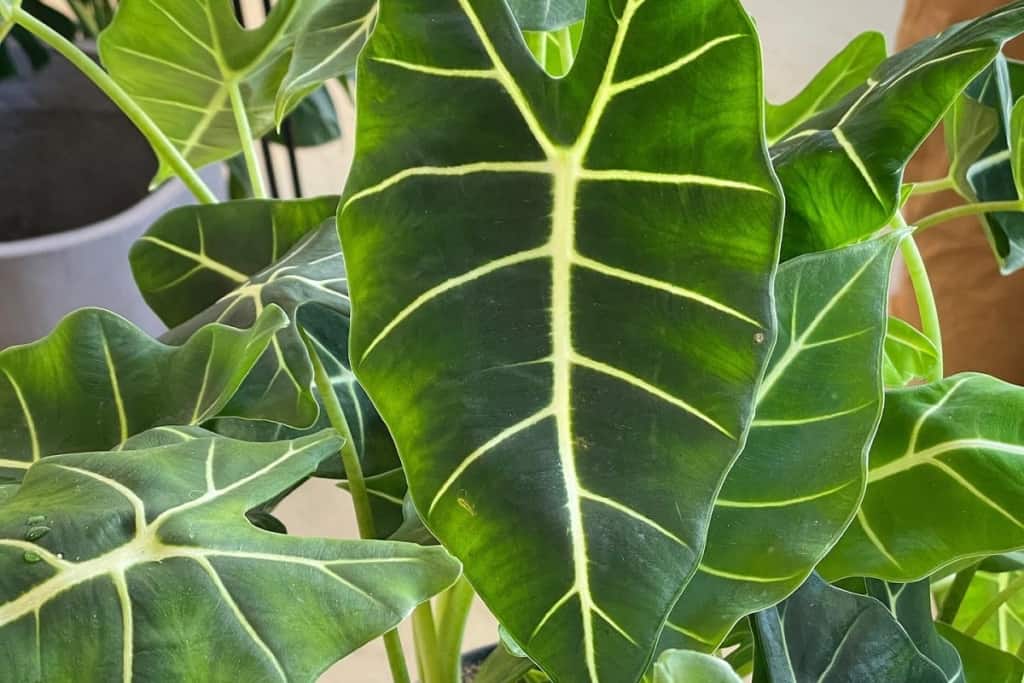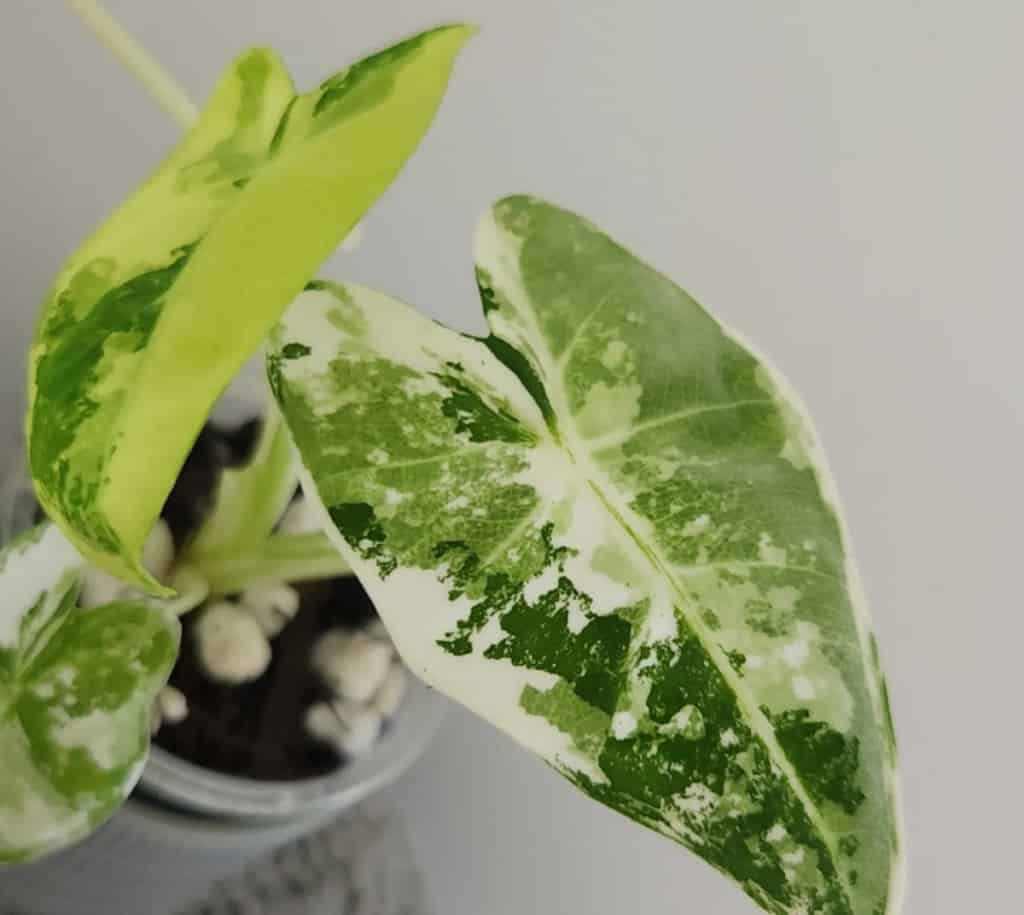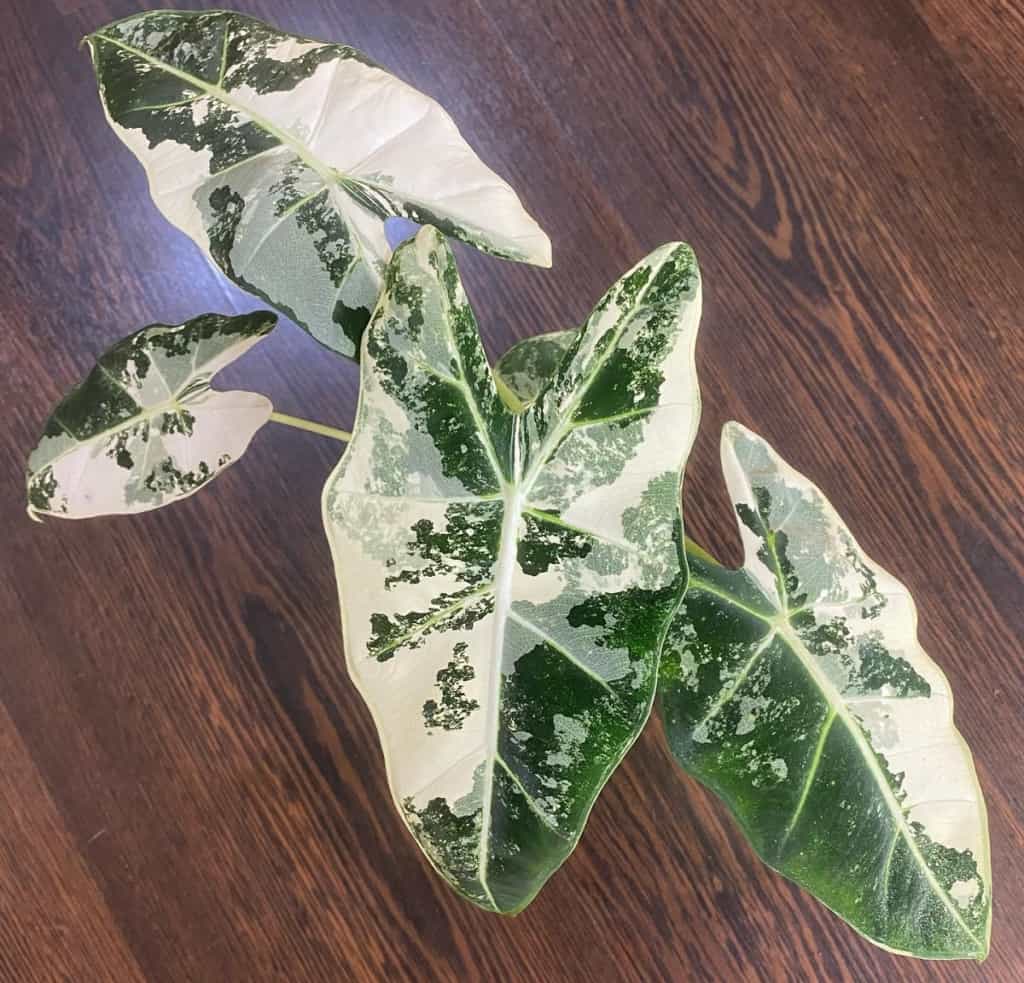In this blog post, we’ll explore everything you need to know about the Alocasia Frydek humidity requirements, including why humidity is important, how to measure it, and tips for maintaining the perfect level of humidity for your plant. So whether you’re a seasoned plant parent or a newbie to the plant world, read on to discover how to keep your Alocasia Frydek happy and healthy.

If you’re a plant enthusiast, chances are you’ve come across the Alocasia Frydek, an exotic plant known for its striking, dark green leaves and distinctive white veins. This plant, also known as Alocasia micholitziana ‘Frydek,’ is a popular choice for indoor plant lovers because of its unique appearance and relatively easy care.
However, like most plants, the Alocasia Frydek has specific requirements when it comes to its environment, and one of the most important factors to consider is humidity. But what exactly is humidity, and how can you ensure that your Alocasia Frydek has the right level of humidity to keep it healthy and thriving? Let’s find out!
Contents
Does Alocasia Frydek Like Humidity?
Humidity is an important factor to consider when growing any plant, and Alocasia is no exception. In fact, this tropical plant actually needs higher levels of humidity than many other plants, making it especially sensitive to the environment around it. Considering how much extra attention these plants need, you may be wondering if they really like or even require high amounts of humidity.
The answer is yes! Alocasias thrive in humid climates and cannot survive without adequate moisture in their immediate environment. These plants are native to tropical regions where humidity is naturally very high all year round; so for anyone trying to grow them outside of such places, creating a similar atmosphere indoors will give your Alocasia its best chance at survival and growth. Therefore, if you’re thinking about introducing this stunning foliage into your home then make sure you understand what kind of environment it requires.
Fortunately, there are various ways to increase the humidity level around your alocasia – from using a humidifier or placing trays with moist pebbles underneath the pot—so that your new houseplant can get all the hydration it needs. Just remember that too much water isn’t ideal either as this could cause root rot which would, unfortunately, mean goodbye alocasia! It’s also worth noting that while increasing the overall humidity in your house might benefit other plants as well, don’t forget who needs it most—your beloved alocasia!
Therefore, providing enough humidity for an alocasia should definitely be on top of any gardener’s priority list if they want their exotic beauty to reach its full potential. To ensure success keep a close eye on both temperature and moisture levels surrounding your plant and adjust accordingly for optimal results.

How To Measure Humidity Level?
The humidity level of your home can have a significant impact on the atmosphere. It’s like having an invisible layer that affects our comfort and well-being, yet it is often overlooked and underestimated. Measuring this relative humidity could be trickier than you think—but luckily, understanding how to do so is not as difficult as one might imagine.
Keeping track of the humidity in your space requires some knowledge of analog hygrometers or portable hygrometers—both are commonly used tools for obtaining accurate readings. Analog hygrometers measure the air’s moisture content with precision, while portable hygrometers allow us to easily transport them from room to room and observe fluctuations.
When using either device, it’s important to familiarize yourself with their features before going ahead with any measurements. Every type has different ranges of accuracy and resolution; if you want precise results, make sure you get one that meets your specific needs. Furthermore, always remember to keep the instrument away from direct sunlight or sources of heat to avoid inaccurate readings!
- Face Icon Comfort Indicator
- Highly Accurate Sensors
- Fast Refresh Rate
- Compact Display with Large Digits
- Multiple Placement Options - Tabletop Stand / Magnetic Back / Hanging Mount
Using these helpful tools correctly gives us the power to monitor changes in our environment over time and take appropriate actions accordingly. Keeping tabs on relative humidity levels will help ensure a safe and comfortable living space for everyone involved—no matter what kind of climate we’re dealing with!
How Much Humidity Does Alocasia Need?
In terms of what kind of environment best suits an Alocasia plant, high levels of humidity are a must! Generally speaking, they love warm temperatures and natural light as well as intense moisture in their surrounding air—something close to 80% relative humidity if possible. You can easily measure the level of humidity with a hygrometer or even use water-filled trays beneath flower pots or saucers filled with pebbles and water around the plants.
Regular misting will also help keep the leaves from drying out; however, make sure not to do this too often because too much wetness can lead to rot. If there isn’t enough ambient moisture in the room where your Alocasia resides, you may need to consider investing in a humidifier to give them just what they need!
Whether using methods such as those mentioned above or taking other measures to increase air moisture levels near your fussy friend, following these recommendations should ensure that they get all the attention they deserve!
Factors That Affect Humidity
One of the simplest ways to add moisture to your air is by using a humidity tray with water in it. Place a shallow bowl filled with rocks and water near your plant and let evaporation increase the level of moisture in the air around it. This method works best if you have multiple houseplants close together, as they will benefit from the increased humidity levels throughout their environment.
Another way to help regulate humidity is through regular misting which adds extra moisture without drowning the roots of your plants. Make sure not to over-mist though, as too much can cause rot! You should also keep an eye out for signs such as yellow leaves or wilting, which could be indicators that you need more humidity in order to prevent further damage.
Air circulation is one other factor that impacts how humid your environment is. If there are no windows open or fans running then stale air can become trapped inside leading to dryness; however, having too much airflow can reduce natural moisture too quickly so monitor carefully and adjust accordingly.
Tip
To make sure all potential sources of humidity are being taken advantage of, try placing a bowl of warm water near any heaters or radiators – just make sure it’s far enough away so it doesn’t evaporate too quickly!
How To Give Alocasia Frydek Humidity

One way to provide humidity is by using an indoor humidifier in the room where your alocasia grows. This will increase the moisture content in the air without having to mist or spray water directly onto your plant’s leaves. You should check the manual for instructions on how much additional moisture your particular model adds so that you can adjust accordingly.
Another option is to create a mini greenhouse for your alocasia. To do this, simply place clear plastic bags over each pot before putting them inside a larger container such as a terrarium or large plastic bin with a lid. Make sure not to seal it too tightly; allow some fresh air into the space but also keep out any drafts from windows or doors. By trapping warm moist air around each individual pot, you can create just enough extra humidity levels needed by your plants while still allowing ventilation and adequate light exposure.
Finally, it’s important to inspect all of your plants regularly for signs of pest infestation or fungal growth which could indicate leaf diseases caused by inadequate humidity levels. Be sure to prune off affected areas immediately and monitor closely until symptoms disappear completely—this way you can ensure that both your plants remain healthy and happy!
Frequently Asked Questions
Can Alocasia grow in low humidity?
No, Alocasia plants prefer high humidity levels and will not thrive in low humidity. A humid environment helps the plant to stay hydrated and prevents it from drying out. When grown in an environment with low humidity, Alocasia plants are prone to wilting, browning of leaves, and insect infestation.
Can Alocasia have too much humidity?
No, Alocasia can not have too much humidity. This is because Alocasia leaves are covered with a layer of wax that helps to reduce the rate of evaporation from the leaves. The waxy coating also helps to reduce the amount of water that can be absorbed through the leaves, thus reducing the amount of water that is lost due to transpiration. The thick leaves also help to minimize the amount of water lost to the atmosphere, further allowing the plant to withstand higher levels of humidity.
Should you mist Alocasia Frydek?
Yes, Alocasias do like to be misted, especially during periods of low humidity. Misting can help to replicate the humid environment that these plants naturally prefer, and it can also help to promote better leaf growth. Misting should be done regularly, especially during the winter months when humidity levels are typically low.
When misting Alocasias, it is important to keep the leaves dry and to avoid getting water on the plant’s roots, as this can lead to root rot. It is also important to use distilled or filtered water, as other water sources may contain chlorine and other minerals that could be damaging to the plant. If you do find yourself needing to mist frequently, it is best to use a spray bottle specifically designed for misting plants.
Conclusion
In conclusion, it is clear that Alocasia plants need humidity to stay healthy and thrive. To ensure they have the right amount of moisture in their environment, it’s important to measure the humidity levels regularly. With some changes to your home or garden, like misting them daily or adding a humidifier, you can easily give your alocasias all the hydration they need.
So while caring for these unique plants may seem daunting at first glance, with just a few simple steps you can make sure they get everything they want and more. Additionally, by understanding how different factors affect the level of humidity around an Alocasia plant, you’ll be able to provide ideal conditions for growth.
Therefore, if you’re looking for a beautiful addition to your home or outdoor space, Alocasia might be just what you need! Not only are these exotic-looking plants captivatingly stunning, but also surprisingly low maintenance—as long as you remember to keep an eye on their humidity requirements.

